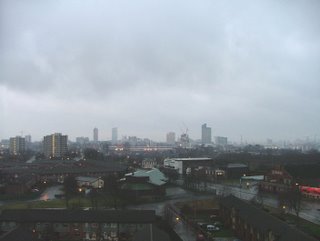TREES IN THE CITY


THE REGREENING OF MANCHESTER
"The spread of the city, as is obvious in this image, and the 'cult of the urbanism' and all that implies for the environment as a whole has paid, for the most part, lip service to Green spaces. Here in this 'before and after scenario' the provinces return and there is a dramatic re-assertion of the rights of the Tree and so nature as a whole takes its rightly place, at the centre of things. '
Anthony C. Trebilcock is a visual/performance artist, based in Manchester, currently working with the theme of Nature in relation to the city. (tonytrebilcock@yahoo.co.uk)
Thursday March 10: 1.7 million pound investment to tackle North Manchester’s derelict land
The Northwest Regional Development Agency (NWDA) and its partners announced that North Manchester’s Harpurhey district is to receive more than one million pounds of regeneration funding to create and manage a new community woodland.The 21-hectare site, known as Moston Vale, has been selected and approved for regeneration under the ‘Newlands’ scheme, a programme billed as ‘land regeneration for the 21st Century’.
The scheme is set rejuvenate more than 400 hectares of the region’s damaged land, boosting economic and social conditions across Greater Manchester and Merseyside. Moston Vale is the first Newlands site to be given the green light for work to start.Newlands at Moston Vale will also support and enhance the wider Irk Valley Project – a public and private partnership to establish a green corridor through the heart of North Manchester, which follows the river Irk and its tributaries, for the benefit and use of the local community.
The community woodland to be created at Moston Vale will be managed by the Forestry Commission with improvements undertaken by its partners; Groundwork, Red Rose Forest and Manchester City Council.
In preparation for today’s announcement, communities surrounding and users of Moston Vale as well as potential visitors to the site, like employees at Central Park, have been consulted about the changes they would like to see to the area. Including work to repair the damaged biodiversity of the site, the land’s regeneration will include the development of family-friendly spaces, a new sports pitch, wildflower area, solar-powered lighting and a recycled gravel footpath.
Newlands at Moston Vale will lead to the creation of thriving, durable woodland for the local community as well as increasing woodland cover in the region, which is significantly lower than national and European figures. Moston Vale as well as the other six Newlands Phase One sites currently under consideration were carefully chosen following an intensive and ground-breaking survey, which used region-wide aerial photography to highlight the Northwest’s areas of derelict, underused or neglected (DUN) land.
16 September 2005: MANCHESTER TREE CONFERENCE
On , The Manchester Tree Conference took place at the Manchester Museum in the city, aimed at providing a rallying call to everyone interested in protecting and looking after some of city’s most prized natural assets - from street trees to park woods.
More than 70 delegates attended the Conference including individual residents, community groups, developers, architects, planners and council officers. They debatedthe important role played by trees in shaping Manchester’s image and identity and the vital contribution that trees make to the quality of life of residents as the air conditioners of the City.
Speakers at the day-long event include writer, broadcaster and leading environmental campaigner Professor Chris Baines and Nigel Blandford, Red Rose Forest’s Operations Manager. The hope of the event's organisers was that delegates would shape a new strategy for the protection and management of the city’s tree population and help draw up guidelines for planting schemes and community involvement.
Councillor Neil Swannick, Executive Member for Planning & the Environment, told the conference : “ Our plans to make Manchester the greenest city in the country recognise that the quality of our environment underpins the quality of life in our communities. Trees have a major role to play in these plans. We want to have a wide ranging discussion at the conference to ensure that the views of everyone who lives in , works in and visits Manchester are included in our future strategy. “
Media contact
Chris Lee, Tel: 0161 234 4027
2nd September 2004: Thousands of Manchester trees dying to fatal ‘scab disease’
A disease, which was once thought to be almost non existent in Britain, is killing thousands of Poplar trees across Greater Manchester, devastating tree stocks and threatening the Manchester Poplar with extinction, announced Red Rose Forest, Greater Manchester’s Community Forest today.
The trees affected are the commonly known ‘Manchester Poplar’ – one of Britain’s rarest native trees and Greater Manchester’s own species. It is estimated that more than four thousand trees have already been attacked by the ‘Poplar Scab’ (as it is currently known), but exact figures are impossibly to quantify as the tree is very common within this part of the country. The effect of this scab is also extremely dramatic, as the vast majority of Manchester Poplars are now mature trees towering at around 75 – 100 feet high.
Experts fear that if this disease is left unchecked, it could spell the extinction of the Manchester Poplar.
Poplar Scab was a previously rare disease, which causes the tragic defoliation of trees in the middle of summer, meaning the tree weakens over a period of two or three years, eventually resulting in its death. Other symptoms include the appearance of unsightly black lesions on the leaves, and the overall ‘shriveling’ of the tree, which is noticable to even casual observers.

0 Comments:
Post a Comment
<< Home